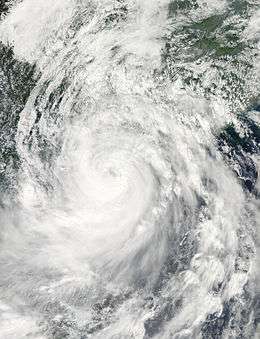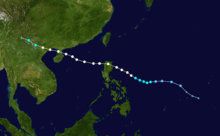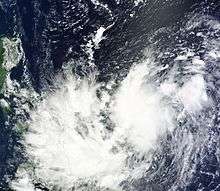Typhoon Kalmaegi (2014)
| Typhoon (JMA scale) | |
|---|---|
| Category 1 (Saffir–Simpson scale) | |
 Typhoon Kalmaegi in peak intensity while landfall Hainan Islands on September 16 | |
| Formed | September 11, 2014 |
| Dissipated | September 18, 2014 |
| Highest winds |
10-minute sustained: 140 km/h (85 mph) 1-minute sustained: 140 km/h (85 mph) |
| Lowest pressure | 960 hPa (mbar); 28.35 inHg |
| Fatalities | 45 total |
| Damage | $75.1 million (2014 USD) |
| Areas affected | |
| Part of the 2014 Pacific typhoon season | |
Typhoon Kalmaegi, known in the Philippines as Typhoon Luis, was the 22nd depression and the 15th named storm of the 2014 typhoon season. Kalmaegi was the first storm to make landfall over the Philippines since Typhoon Rammasun, two months prior. The storm caused flooding in Southeast Asia during mid-September.
Meteorological history

On September 10, a tropical disturbance formed northeast of Palau with a possibility of becoming a tropical cyclone in the next few days.[1] Later the same day, the JTWC had reported that it had intensified into a tropical depression, giving it the designation "15W". Early on September 12, the JMA started to track 15W as a tropical depression. In the same time, PAGASA had issued their first advisories on the storm, naming it as Tropical Depression Luis.[2][3] As Luis entered a more conducive environment, it steadily intensified into a tropical storm and was named Kalmaegi by the JMA later that day and the JTWC followed suit on the same day.[4] The storm entered an area of warm waters as the JMA upgraded it to a typhoon, while JTWC upgraded it to a category 1 typhoon late on September 13. Kalmaegi made landfall over Cagayan early the next day, as it start to interact with land and weakened to a tropical storm. On September 15, Kalmaegi entered the South China Sea and intensified again.[5] The typhoon reached its peak strength while making its second landfall over Hainan Island.[6] Kalmaegi rapidly weakened to a large tropical storm as it continued to move in a westward direction. Both agencies classified Kalmaegi as a tropical depression. Later that day, both agencies announced that Kalmaegi had dissipated.[7]
Preparations and impact
Philippines

Known in the Philippines as Luis, PAGASA had issued some first Signal Warnings over Region II on September 13.[8] PAGASA had also warned residents in regions of Luzon about landslides, thunderstorms and flash floods from the effects of Luis. Several rubber boats and medical aid supplies were prepared.[9]
As the storm was exiting the country, PAGASA reported that the province of Pangasinan was under the "state of calamity" due to flash floods, especially towns in Calasiao, Santa Barbara and even as far as Urdaneta.[10] Meanwhile, the NDRRMC said that landslides had occurred in Cagayan Valley as of September 17. It was also reported that at least 200 houses had been destroyed while 600 were damaged.[11]
As for impacts in the Philippines, a total of 12 people were killed by the storm with eight of them drowning as the boat they were on sank due to rogue waves caused by the storm.[12][13] According to the NDRRMC, damages amounted to $18.3 million USD, as of September 19.[14]
China
On September 15, the government weather bureau reported that the storm was headed toward southern China at about 19 mph.[15] In Haikou, the capital of Hainan Province, schools were ordered to close on September 16 and 17.[16] Later that day, the storm hit Hong Kong, disrupting flights and forcing the stock market to close, as well as causing 29 injuries. The stock market reopened Tuesday morning. The storm hit Hainan on September 16, where more than 90,000 people were evacuated from its east coast prior to the storm's impact.[17] As of September 20, the storm had killed at least eight people and caused damages of US$55.86 million.[18]
Vietnam
The typhoon was also felt in Vietnam, with strong gusty winds and flash floods reported. As of September 18, it was reported that the death toll had risen to 9 and 10 were injured. Damages has also been topped to VND20 billion ($944 thousand USD).[19] Another 2 were reported killed on the same day.[20] On September 19, it was reported that 15 were injured. So far, a total of 13 people were reported killed by the storm.[21]
India
After the dissipation of Kalmaegi, its remnants continued to move towards Eastern India on September 19. With this, it caused flash floods and landslides over the area until it dissipated on September 23. On September 22, it was reported that a total of 12 people had been killed in Meghalaya in the past 72 hours. Several bridges were also reported destroyed.[22]
Aftermath

Tropical Storm Fung-wong
On September 16, PAGASA was monitoring a tropical depression in the Philippine Sea, which had the possibility of following the same track Kalamaegi took. The storm had intensified into Tropical Storm Fung-wong, known in the Philippines as Mario. On September 19, Fung-wong affected most of Luzon, bringing and continuing severe flooding in places, especially Manila. Rain bands from Fung-wong have brought widespread rainfall of 100-200 millimeters (4-8 inches) to Eastern Visayas and southeastern Luzon in under 24 hours.[23] PAGASA has issued Signal Warning#2 in places where Kalmaegi made its first landfall.[24]
On September 19, it was reported that a 12-year-old girl was killed due to extreme flooding in Quezon City.[25] In the same day, Fung-wong made landfall over the northern tip of Cagayan.[26] With the combination of Kalmaegi and Fung-wong, a total of 30 people were dead in the Philippines and a total of $93.8 million USD as of September 30.
See also
References
- ↑ "Developing Storm to Impact the Philippines, Possible Kalmaegi (Luis)". Robert Speta. Retrieved September 9, 2014.
- ↑ "Tropical depression Luis enters PHL, may bring rain this weekend". Joel Locsin. Retrieved September 12, 2014.
- ↑ "Bagyo Luis / Developing Kalmagi Moving towards Luzon (Friday AM Update". Robert Speta. Retrieved September 11, 2014.
- ↑ "NASA Sees Tropical Storm Kalmaegi Swirl Toward the Philippines". Rob Gutro, NASA. September 12, 2014.
- ↑ "Sees Typhoon Kalmaegi as a Whirlpool of Clouds in the South China Sea". Rob Gutro, NASA. September 15, 2014.
- ↑ "NASA Spots Center of Typhoon Kalmaegi Over Hainan Island, Headed for Vietnam". Rob Gutro, NASA. September 16, 2014.
- ↑ "NASA Sees Tropical Storm Kalmaegi Weakening Over Vietnam". Rob Gutro, NASA. September 17, 2014.
- ↑ "Weather Bulletin No.05 re Tropical Storm "LUIS"" (PDF). NDRRMC. Retrieved September 13, 2014.
- ↑ "SitRep No.1 re Preparedness Measures for Tropical Storm "LUIS" (KALMAEGI)" (PDF). NDRRMC. Retrieved September 13, 2014.
- ↑ "Ilang bahagi ng Pangasinan, lubog pa rin sa baha; bayan ng Calasiao, isinailalim sa state of calamity". FRJ, GMA News. Retrieved September 16, 2014.
- ↑ "NDRRMC: Pangasinan town in state of calamity due to Luis, revised death toll up to 4". Joel Locsin, GMA News. Retrieved September 17, 2014.
- ↑ "Maharlika 2 ferry was 'old' and 'rusty'". Retrieved September 15, 2014.
- ↑ "Philippines Ferry Sinking: 70 Missing After MV Maharlika 2 Sinks Off Southern Leyte Province". September 13, 2014.
- ↑ "SitRep No. 12 re Effects of Typhoon "LUIS" (KALMAEGI)" (PDF). NDRRMC. Retrieved September 19, 2014.
- ↑ Associated Press (15 September 2014). "Typhoon blows out of Philippines, heads to China". Washington Post. Retrieved 15 September 2014.
- ↑ http://edu.china.com.cn/2014-09/15/content_33515263.htm
- ↑ Agence France-Presse (16 September 2014). "Typhoon Kalmaegi hits Chinese island after Hong Kong shutdown". The Guardian. Retrieved 16 September 2014.
- ↑ "Death toll from Typhoon Kalmaegi rises to eight, 396 trapped students saved". September 20, 2014. Retrieved September 20, 2014.
- ↑ "Nine dead, 10 injured in wake of Typhoon Kalmaegi". Retrieved September 18, 2014.
- ↑ "11 dead after Typhoon Kalmaegi slams into Vietnam". Retrieved September 18, 2014.
- ↑ "13 dead, 15 injured by Typhoon Kalmaegi". Retrieved September 19, 2014.
- ↑ "Landslides, flash floods in Meghalaya kill 7". Retrieved September 22, 2014.
- ↑ "Fung-wong to Impact Philippines, Taiwan and Japan". Eric Leister. Retrieved September 19, 2014.
- ↑ "Situational Report No.1 re Preparedness Measures for Tropical Storm "MARIO"" (PDF). NDRRMC. Retrieved September 18, 2014.
- ↑ "Girl dies from Quezon City floods – report". GMA News. Retrieved September 19, 2014.
- ↑ "Mario makes landfall over north Cagayan; 14 areas under storm signals". GMA News. Retrieved September 19, 2014.
External links
- Animation sequence from the Hong Kong Observatory
